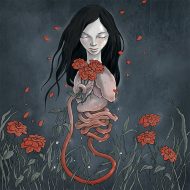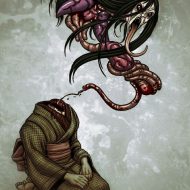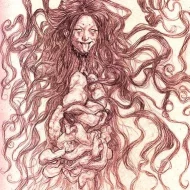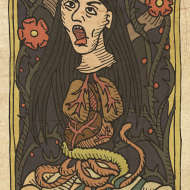Penanggalan : The Vampire Lady
Listen
At a glance
| Description | |
|---|---|
| Origin | Malaysian Mythology |
| Classification | Ghosts |
| Family Members | N/A |
| Region | Malaysia |
| Associated With | Blood Sucking, Evil, Pregnant Women |
Penanggalan
Introduction
The penanggal or penanggalan is a vampiric entity that originates from Malay ghost folklore and is active during the night. Its name is derived from the word “tanggal,” meaning to put off or take off, reflecting its appearance as a floating disembodied woman’s head with trailing organs still attached. When observed from a distance, it resembles a flickering ball of flame, providing a possible explanation for the will-o’-the-wisp phenomenon.
Although commonly referred to as a ghost in its native languages, the penanggalan doesn’t neatly fit into the category of a traditional undead being. Instead, it is described as a witch who gained the ability to assume this form through meditation in a vat of vinegar. The creature essentially remains a living human being during daylight or whenever it is not detached from its body. The penanggalan typically engages in nocturnal hunting, seeking menstruation/blood from births, as well as targeting pregnant women and young children.
Physical Traits
By day, the Penanggalan assumes the appearance of an ordinary human woman. However, come nightfall, this dreadful specter detaches its head and takes to the skies independently. With its internal organs hanging beneath, they reportedly sparkle like fireflies in the moonlit night. As it soars, its long, disheveled hair billows around, and its luminous red eyes cut through the darkness.
While the Penanggalan primarily employs its invisible tongue to feed on its prey, it is often depicted with fangs. The number of fangs varies from region to region, with some accounts suggesting two, akin to the Western vampire, while others assert that the typical Penanggalan is adorned with a mouthful of fangs.
Family
In the realm of traditional Malaysian folklore, the penanggalang is said to be created when a woman, be it old or young, delves into black magic in pursuit of eternal beauty. Typically, this involves making a pact with the devil, wherein one of the conditions stipulates abstaining from meat for 40 days. Should this covenant be broken, the woman transforms into a bloodthirsty Penanggalan. Alternatively, instances exist where women, through childbirth or powerful uncontrollable curses, succumb to becoming penanggalans, though these occurrences are less frequent.
Another Malaysian narrative recounts the tale of the original Penanggalang, once a beautiful priestess. During a ceremonial bath in a vinegar-filled tub, she was unexpectedly startled by a man entering her room. Startled, she abruptly lifted her head to look at him, resulting in such forceful decapitation that locals have humorously dubbed it the “overreaction of the century.” In this version, the reason for Penanggalans targeting pregnant women and newborns remains unclear.
A more plausible rendition suggests that the original Penanggalang was an unattractive young woman embittered by her single status and intensely envious of married women. This resentment led to a murderous rampage, claiming the lives of numerous innocent pregnant women. As punishment for her heinous acts, villagers hung her head from a tall tree, tethering her legs to a bull. While the head hung from the tree, all internal organs remained intact. Victorious in their battle against evil, the villagers celebrated, only to discover that the severed head had vanished that night, inadvertently unleashing hellish demons upon their small settlement.
Other names
The penanggalan goes by distinct names across various regions in Southeast Asia. It is referred to as balan-balan in Sabah, tengelong or tengalong in Kedah, hantu polong among the Temuan, leyak in Bali, kuyang in Kalimantan, palasik in West Sumatra, kra-sue in Thailand, kasu in Laos, ahp in Cambodia, and manananggal in the Philippines.
Powers and Abilities
Unlike other vampiric beings, Penanggalan are exclusively female and possess the ability to blend in as ordinary human beings during the daytime, revealing their monstrous forms only at night. They tend to target pregnant women and newborn babies, often opting for roles such as midwives. By day, the Penanggalan typically leads a normal life as an everyday woman. However, when night falls, it separates its head from its body and takes to the skies in search of blood.
Functioning as an omen of childbirth, the Penanggalan perches on the rooftops of homes where women are in labor, patiently awaiting the moment. As the woman gives birth, the Penanggalan extends its invisible tongue into the dwelling, initiating the draining of the new mother’s blood. In certain cases, it might also consume the placenta, extract the blood of the newborn, and indulge in the flesh of its victims. While the Penanggalan seldom completely drains its victims, those who have been preyed upon by it often succumb to a wasting ailment that is nearly inevitably fatal.
Modern Day Influence
The penanggalan made its appearance as a creature in the 1981 Dungeons & Dragons rulebook Fiend Folio. In the Hellboy: The Troll Witch and Others comics, Hellboy ventures to Malaysia in 1958, encountering a village without a Bomoh shaman that has fallen prey to a demonic penanggalan. The 2016 Image Comic Cry Havoc introduces a character named Sri who reveals herself as a penanggalan, detailing how her head detaches from her body and “slithers around like an electric eel.” Furthermore, the Penanggalan is featured as an enemy type in the 1991 RPG Dark Conspiracy, specifically in the supplement Dark Races, where it is portrayed as a parasite residing in a host’s skull, detaching when threatened.
Related Images
Frequently Asked Questions
What is lorem Ipsum?
I am text block. Click edit button to change this text. Lorem ipsum dolor sit amet, consectetur adipiscing elit. Ut elit tellus, luctus nec ullamcorper mattis, pulvinar dapibus leo.
What is lorem Ipsum?
I am text block. Click edit button to change this text. Lorem ipsum dolor sit amet, consectetur adipiscing elit. Ut elit tellus, luctus nec ullamcorper mattis, pulvinar dapibus leo.
What is lorem Ipsum?
I am text block. Click edit button to change this text. Lorem ipsum dolor sit amet, consectetur adipiscing elit. Ut elit tellus, luctus nec ullamcorper mattis, pulvinar dapibus leo.
What is lorem Ipsum?
I am text block. Click edit button to change this text. Lorem ipsum dolor sit amet, consectetur adipiscing elit. Ut elit tellus, luctus nec ullamcorper mattis, pulvinar dapibus leo.
What is lorem Ipsum?
I am text block. Click edit button to change this text. Lorem ipsum dolor sit amet, consectetur adipiscing elit. Ut elit tellus, luctus nec ullamcorper mattis, pulvinar dapibus leo.









